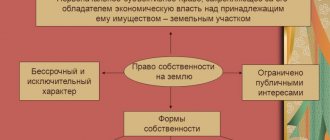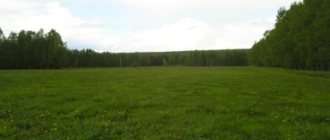Home / Real estate / Land / Ownership / Forms of ownership
Back
Published: 06/21/2017
Reading time: 10 min
0
802
All land plots in the Russian Federation are either privately owned by individuals or legal entities, or owned by the state.
State lands are divided into federal, regional and municipal (city) under a special procedure called the delimitation of state land ownership.
- The concept of federal property
- Legislation
- Reasons for occurrence
- Federally owned lands
- Procedure for delimiting federal ownership of land
- The procedure for transferring land from federal to municipal ownership
- If it is necessary to carry out boundary work to form the boundaries of the site
- Transfer Features
The concept of federal property
Federally owned lands are areas that are in state ownership along with regional and municipal lands (clause 2 of article 16 of the Land Code of the Russian Federation).
A distinctive feature of federal lands is that they are at the disposal of the federal authorities and can only be regulated by the laws of the federation and decrees of the government of the Russian Federation.
Regional or municipal authorities cannot dispose of federal lands before they are demarcated into the ownership of subjects or cities of the Russian Federation.
According to paragraph 1 of Art. 16 of the Land Code of the Russian Federation, plots of land in federal ownership cannot be located:
- In municipal ownership;
- Owned by commercial organizations and other legal entities;
- Owned by citizens - individuals.
Federal ownership of land plots is formed as a result of the designation of its boundaries (delimitation) on the cadastral map of state lands in accordance with government regulations.
Who actually owns Russia's natural resources - what the law says
And the oil and gas industry alone accounts for more than 1/3 of the budget system’s revenues. But what relation do the people themselves have to resources, and who owns the “national wealth”: all citizens, the state or individuals - the owners? The answer to this question can be found in the Constitution of the Russian Federation and the Law “On Subsoil”.
The article will clearly distinguish between the resources contained in the subsoil and those extracted from them. Thus, Part 1 states that all minerals and natural resources contained in the subsoil are state property. And the state can decide issues of ownership, use and disposal of them.
Legislation
Legal regulation of federal land holdings is carried out within the framework of:
- Land Code (Land Code of the Russian Federation);
- Law No. 137 “On the entry into force of the Land Code of the Russian Federation”;
- Forest Code;
- Other federal laws and government regulations.
According to paragraph 2 of Art. 16 of the Land Code of the Russian Federation, the classification of lands as federal property is carried out by adopting the relevant federal laws.
Types of state property
Objects classified as state property are established by law. They:
- They form the basis of Russia's national wealth.
- Necessary for the work of government bodies and solving problems on a national scale.
- Refers to defense production.
- Ensure the vital activity and development of the national economy.
- Refers to other objects.
Let's briefly consider each of them separately.
Reasons for occurrence
According to paragraph 1 of Art. 17 of the Land Code of the Russian Federation, the emergence of federal ownership of land occurs as a result of:
- Adoption of relevant laws;
- Delineation of state land holdings;
- Acquisition of land by the Russian government.
In particular, paragraph 1 of Art. 8 of the Forest Code classifies all forest lands as federal property, as does Art. 29 of Law No. 57 “On State Protection” classifies the areas where the relevant services are located as federal lands.
Delimitation implies the allocation of lands into the category of federal possessions from undelimited state plots or from plots of federal subjects by transferring them under federal jurisdiction.
Lands can also be acquired into federal ownership:
- For individuals;
- In municipalities;
- In other states.
Acquired lands from federal property may also be located outside the state border, for example, the residences of Russian ambassadors in foreign countries are located on the federal possessions of the Russian Federation.
Grounds for seizure of land
The grounds and conditions necessary for the seizure of land plots are exhaustive and are enshrined in Art. 49 RF Land Code:
- the transfer of land for state needs occurs if in this way the Russian Federation can solve its problems with fulfilling international obligations
- transfer of plots from private to state ownership occurs in cases where it is necessary to locate a state facility, but there are no other options for construction
- after the occurrence of circumstances established by federal legislation, the procedure for the redemption of territories may begin.
However, the regulatory legal act of the Russian Federation provides for cases when the transfer of land is impossible, even if the conditions listed above are met:
- lands that are located on the territory of specially protected zones cannot be subject to seizure, since they have a special legal regime for their use (Article 93 of the Land Code of the Russian Federation);
- lands of forest areas that belong to the first group (Article 101 of the Land Code of the Russian Federation).
Such restriction conditions are necessary to ensure that the interests of protecting forest, nature reserve and agricultural areas are respected.
Federally owned lands
According to paragraph 1 of Art. 3.1 Federal Law No. 137, the following territories belong to federal property:
- Allotments located under residential and non-residential buildings that are the property of the Russian Federation;
- Lands of authorities and their representative offices;
- Lands of state-owned and unitary enterprises;
- Lands used by the Academy of Sciences and related institutions;
- Roads and passages related to the state company Rosavtorogi;
- Lands of forest and water funds;
- Reserve lands;
- Land Defense;
- Closed cities;
- Reserve lands.
The lands of unitary enterprises under the jurisdiction of municipalities are not federal territories; also, individual reserves may be part of the lands of federal subjects.
You can determine whether a land plot is federal property on the Rosreestr website using its cadastral number.
If a plot does not have a fixed number on the state cadastral map, it means that it has not yet been demarcated from state lands.
The basis of the country's wealth
The objects that form the basis of Russia's wealth are:
- Resources related to the continental shelf, territorial waters and seas of the Russian Federation.
- Natural objects that are protected or used in a special way. These include nature reserves, national parks, resorts and wildlife sanctuaries.
- Historical, cultural and natural sites, cultural institutions and artistic values.
Objects for the functioning of government agencies and the management of government tasks
The objects that are needed for the work of government agencies and the management of national tasks include the following:
- The state treasury of the country.
- Property owned by the armed forces, police departments and other institutions, financed from the federal treasury.
- Universities, research institutes, enterprises and other facilities of the Russian Academy of Sciences, ministries, state research centers.
- Enterprises and other geological, geodetic, hydrometeorological and other services.
- Enterprises and institutions of sanitary and epidemiological and veterinary services.
- Patent service enterprises, metrological and machine testing stations.
- State reserves and reserves, enterprises that preserve them.
- Correctional institutions, medical and preventive enterprises.
Defense production
Defense production facilities include:
- Enterprises that produce weapons, explosives and toxic substances, radiation materials, rockets, space flight devices, equipment for the military; enterprises that service, launch and support spacecraft carry out research and development work in these areas.
- Premises of reserve points for the management of all government bodies and communication facilities, as well as infrastructure, which are intended for use at special times.
Objects for work and development of the national economy
Objects that ensure the work and development of the national economy:
- Enterprises related to the mining industry.
- Fuel and energy complex.
- Electrical energy.
- Railway, air, water, pipeline transport, gasification.
- Public roads and organizations that maintain them.
- Television, radio enterprises, communications.
- Breeding and equestrian state farms and factories, breeding centers, state inspections, laboratories for testing agricultural crops, fish production farms, serpentariums.
Other objects
Other objects include:
- Pharmaceutical enterprises for the production of medical and biological drugs.
- For the production of alcohol and vodka products.
Procedure for delimiting federal ownership of land
Federal land ownership is formed as a result of the delimitation of state undivided lands in the following order:
- A draft law on the delimitation of state property into federal property is being formed;
- A separate resolution initiates cadastral work;
- The boundaries of the state plot are fixed and a unique cadastral number is assigned;
- A law is adopted defining the affiliation of the formed area with federal ownership.
The law specifies the category of land of the formed area of federal land, the intended purpose and standards of operation and provision. To change the boundaries of already existing federal lands, amendments to existing laws (Forestry, Water Code), as well as the boundaries of their applicability, can be adopted.
Cadastral work when determining the boundaries of federal lands allocated from state property is carried out in accordance with the preliminary project, which is approved by the government of the Russian Federation.
In practice it looks like this:
- The government decides to create a reserve as part of federal property;
- Employees of the Ministry of Land Resources are drawing up a diagram of the future site;
- The scheme is agreed upon, approved and sent to the cadastral service to carry out geodetic work on the ground;
- The boundary plan of the future site completed by cadastral engineers, prepared in accordance with the scheme, is sent to the Ministry of Land Resources;
- The boundary plan is agreed upon and approved by the ministry. If necessary, clarification work is carried out.
The type of boundary work carried out when delimiting a site from state to federal property depends on the presence of primary boundaries and the scale of their changes.
If the site was formed earlier and only its category and/or affiliation changes, then only work is carried out to clarify the boundaries, and primary boundary work to form boundaries (with the assignment of a cadastral number) is carried out if the site is formed for the first time.
Federal lands, in turn, can be transferred to the ownership of federal subjects or municipal authorities.
Documents Statistics on documents and execution of orders
RUSSIAN FEDERATION
Land Code of the Russian Federation
Adopted by the State Duma on September 28, 2001
Approved by the Federation Council on October 10, 2001
(As amended by federal laws dated June 30, 2003 No. 86-FZ, dated June 29, 2004 No. 58-FZ, dated October 3, 2004 No. 123-FZ, dated December 21, 2004 No. 172-FZ, dated December 29, 2004 No. 189-FZ, dated December 29, 2004 No. 191-FZ, dated March 7, 2005 No. 15-FZ, dated July 21, 2005 No. 111-FZ, dated July 22, 2005 No. 117-FZ, dated December 31, 2005 No. 206-FZ, dated April 17, 2006 No. 53-FZ, dated 06/03/2006 No. 73-FZ, dated 06/30/2006 No. 92-FZ, dated 06/30/2006 No. 93-FZ, dated 07/27/2006 No. 154-FZ, dated 10/16/2006 No. 160-FZ, dated 04.12.2006 No. 201-FZ, dated 04.12.2006 No. 204-FZ, dated 12.18.2006 No. 232-FZ, dated 29.12.2006 No. 260-FZ, dated 29.12.2006 No. 261-FZ, dated 28.02.2007 No. 21 -FZ, dated 10.05.2007 No. 69-FZ, dated 19.06.2007 No. 102-FZ, dated 24.07.2007 No. 212-FZ, dated 30.10.2007 No. 240-FZ, dated 08.11.2007 No. 257-FZ, dated 13.05 .2008 No. 66-FZ, dated May 13, 2008 No. 68-FZ, dated July 14, 2008 No. 118-FZ, dated July 22, 2008 No. 141-FZ, dated July 23, 2008 No. 160-FZ, dated December 25, 2008 No. 281- Federal Law, dated December 30, 2008 No. 311-FZ, dated March 14, 2009 No. 32-FZ, dated July 17, 2009 No. 145-FZ, dated July 17, 2009 No. 164-FZ, dated July 24, 2009 No. 209-FZ, dated December 25. 2009 No. 340-FZ, dated December 27, 2009 No. 343-FZ, dated December 27, 2009 No. 365-FZ, dated July 22, 2010 No. 167-FZ, dated December 29, 2010 No. 435-FZ, dated December 29, 2010 No. 442-FZ , dated 03/20/2011 No. 41-FZ, dated 04/05/2011 No. 56-FZ, dated 06/14/2011 No. 138-FZ, dated 07/01/2011 No. 169-FZ, dated 07/11/2011 No. 193-FZ, dated 07/18/2011 No. 214-FZ, dated July 18, 2011 No. 215-FZ, dated July 18, 2011 No. 219-FZ, dated July 18, 2011 No. 242-FZ, dated July 19, 2011 No. 246-FZ, dated July 21, 2011 No. 257-FZ, dated 21.11.2011 No. 331-FZ, dated 30.11.2011 No. 349-FZ, dated 30.11.2011 No. 365-FZ, dated 06.12.2011 No. 401-FZ, dated 07.12.2011 No. 417-FZ, dated 08.12.2011 No. 423-FZ, dated December 8, 2011 No. 424-FZ, dated December 12, 2011 No. 425-FZ, dated December 12, 2011 No. 427-FZ, dated June 25, 2012 No. 93-FZ, dated July 28, 2012 No. 133-FZ, dated 12/30/2012 No. 318-FZ, dated 03/04/2013 No. 21-FZ, dated 04/05/2013 No. 55-FZ, dated 06/07/2013 No. 123-FZ, dated 07/02/2013 No. 148-FZ, dated 07/02/2013 No. 185 -FZ, dated July 23, 2013 No. 247-FZ, dated December 28, 2013 No. 396-FZ, dated December 28, 2013 No. 406-FZ, dated December 28, 2013 No. 411-FZ, dated December 28, 2013 No. 446-FZ, dated June 23 .2014 No. 171-FZ, dated July 21, 2014 No. 217-FZ, dated July 21, 2014 No. 224-FZ, dated July 21, 2014 No. 234-FZ, dated October 22, 2014 No. 315-FZ, dated December 29, 2014 No. 458- Federal Law, dated December 29, 2014 No. 485-FZ, dated December 29, 2014 No. 487-FZ, dated December 31, 2014 No. 499-FZ, dated March 8, 2015 No. 48-FZ, dated April 20, 2015 No. 102-FZ, dated June 29. 2015 No. 206-FZ, dated July 13, 2015 No. 213-FZ, dated July 13, 2015 No. 224-FZ, dated July 13, 2015 No. 233-FZ, dated July 13, 2015 No. 252-FZ, dated October 5, 2015 No. 277-FZ , dated November 28, 2015 No. 357-FZ, dated December 30, 2015 No. 431-FZ, dated December 30, 2015 No. 460-FZ, dated May 1, 2016 No. 119-FZ, dated May 23, 2016 No. 149-FZ, dated June 23, 2016 No. 206-FZ, dated 06/23/2016 No. 221-FZ, dated 07/03/2016 No. 334-FZ, dated 07/03/2016 No. 335-FZ, dated 07/03/2016 No. 336-FZ, dated 07/03/2016 No. 349-FZ, dated 07/03/2016 No. 354-FZ, dated 07/03/2016 No. 361-FZ, dated 07/03/2016 No. 365-FZ, dated 07/03/2016 No. 373-FZ, dated 07/01/2017 No. 141-FZ, dated 07/01/2017 No. 143-FZ, dated July 18, 2017 No. 177-FZ, dated July 29, 2017 No. 216-FZ, dated July 29, 2017 No. 217-FZ, dated July 29, 2017 No. 280-FZ, dated December 31, 2017 No. 506-FZ, dated 12/31/2017 No. 507-FZ, dated 06/27/2018 No. 164-FZ, dated 06/29/2018 No. 171-FZ, dated 07/01/2018 No. 175-FZ, dated 07/03/2018 No. 185-FZ, dated 07/19/2018 No. 212 -FZ, dated 03.08.2018 No. 340-FZ, dated 03.08.2018 No. 341-FZ, dated 03.08.2018 No. 342-FZ, dated 12.18.2018 No. 471-FZ, dated 25.12.2018 No. 485-FZ, dated 27.06 .2019 No. 151-FZ, dated 08/02/2019 No. 283-FZ, dated 12/27/2019 No. 477-FZ, dated 12/27/2019 No. 502-FZ, dated 03/18/2020 No. 66-FZ, dated 07/13/2020 No. 194- Federal Law, dated July 13, 2020 No. 202-FZ, dated July 31, 2020 No. 269-FZ, dated October 15, 2020 No. 318-FZ, dated December 22, 2020 No. 435-FZ, dated December 30, 2020 No. 494-FZ, dated December 30. 2020 No. 505-FZ, dated 04/05/2021 No. 79-FZ, dated 04/20/2021 No. 92-FZ, dated 04/30/2021 No. 113-FZ, dated 04/30/2021 No. 120-FZ, dated 06/11/2021 No. 163-FZ , dated 06/11/2021 No. 170-FZ, dated 06/11/2021 No. 209-FZ, dated 06/28/2021 No. 226-FZ, dated 07/01/2021 No. 273-FZ, dated 07/01/2021 No. 276-FZ, dated 07/02/2021 No. 300-FZ, dated 07/02/2021 No. 302-FZ)
CHAPTER I. GENERAL PROVISIONS
Article 1. Basic principles of land legislation
1. This Code and other acts of land legislation issued in accordance with it are based on the following principles:
1) taking into account the importance of land as the basis of human life and activity, according to which the regulation of relations on the use and protection of land is carried out on the basis of ideas about land as a natural object, protected as the most important component of nature, a natural resource used as a means of production in agriculture economy and forestry and the basis for carrying out economic and other activities on the territory of the Russian Federation, and at the same time as about real estate, about the object of ownership and other rights to land;
2) the priority of protecting land as the most important component of the environment and a means of production in agriculture and forestry over the use of land as real estate, according to which the ownership, use and disposal of land are carried out by the owners of land plots freely, if this does not cause damage to the environment;
3) the priority of protecting human life and health, according to which, when carrying out activities on the use and protection of land, such decisions must be made and such types of activities carried out that would ensure the preservation of human life or prevent negative (harmful) effects on human health, even if this will require large expenses;
4) participation of citizens, public organizations (associations) and religious organizations in resolving issues relating to their rights to land, according to which citizens of the Russian Federation, public organizations (associations) and religious organizations have the right to take part in the preparation of decisions, the implementation of which may have an impact on the condition of lands during their use and protection, and state authorities, local governments, economic and other entities are obliged to ensure the possibility of such participation in the manner and in the forms established by law; (As amended by Federal Law dated October 3, 2004 No. 123-FZ)
5) the unity of fate of land plots and objects firmly associated with them, according to which all objects firmly associated with land plots follow the fate of land plots, with the exception of cases established by federal laws;
6) the priority of preserving especially valuable lands and lands of specially protected areas, according to which a change in the intended purpose of valuable agricultural lands, lands occupied by protective forests, lands of specially protected natural territories and objects, lands occupied by cultural heritage sites, other especially valuable lands and lands specially protected areas for other purposes is limited or prohibited in the manner established by federal laws. The establishment of this principle should not be interpreted as denying or belittling the importance of lands of other categories; (As amended by federal laws dated December 21, 2004 No. 172-FZ; dated December 4, 2006 No. 201-FZ)
7) paid use of land, according to which any use of land is carried out for a fee, except for cases established by federal laws and laws of constituent entities of the Russian Federation;
 division of lands according to their intended purpose into categories, according to which the legal regime of lands is determined based on their belonging to a certain category and permitted use in accordance with zoning of territories and legal requirements; (As amended by Federal Law No. 141-FZ dated July 22, 2008)
division of lands according to their intended purpose into categories, according to which the legal regime of lands is determined based on their belonging to a certain category and permitted use in accordance with zoning of territories and legal requirements; (As amended by Federal Law No. 141-FZ dated July 22, 2008)
9) delimitation of state ownership of land into property of the Russian Federation, property of constituent entities of the Russian Federation and property of municipalities, according to which the legal basis and procedure for such delimitation are established by federal laws;
10) a differentiated approach to establishing the legal regime of lands, according to which natural, social, economic and other factors must be taken into account when determining their legal regime;
11) a combination of the interests of society and the legitimate interests of citizens, according to which the regulation of the use and protection of land is carried out in the interests of the entire society while ensuring guarantees for each citizen for the free possession, use and disposal of the land plot belonging to him.
When regulating land relations, the principle of differentiating the operation of the norms of civil legislation and the norms of land legislation is applied in terms of regulating relations on the use of land, as well as the principle of state regulation of land privatization.
2. Federal laws may establish other principles of land legislation that do not contradict the principles established in paragraph 1 of this article.
Article 2. Land legislation
1. Land legislation in accordance with the Constitution of the Russian Federation is under the joint jurisdiction of the Russian Federation and the constituent entities of the Russian Federation. Land legislation consists of this Code, federal laws and laws of the constituent entities of the Russian Federation adopted in accordance with them.
The norms of land law contained in other federal laws and laws of the constituent entities of the Russian Federation must comply with this Code.
Land relations can also be regulated by decrees of the President of the Russian Federation, which should not contradict this Code or federal laws.
2. The Government of the Russian Federation makes decisions regulating land relations within the powers determined by this Code, federal laws, as well as decrees of the President of the Russian Federation regulating land relations.
3. On the basis of and in pursuance of this Code, federal laws, other regulatory legal acts of the Russian Federation, laws of the constituent entities of the Russian Federation, executive authorities of the constituent entities of the Russian Federation, within the limits of their powers, can issue acts containing norms of land law.
4. On the basis of and in pursuance of this Code, federal laws, other regulatory legal acts of the Russian Federation, laws and other regulatory legal acts of the constituent entities of the Russian Federation, local government bodies, within the limits of their powers, may issue acts containing norms of land law.
Article 3. Relations regulated by land legislation
1. Land legislation regulates relations regarding the use and protection of lands in the Russian Federation as the basis for the life and activities of the peoples living in the relevant territory (land relations).
2. To relations regarding the use and protection of subsoil, water bodies, forests, wildlife and other natural resources, environmental protection, protection of specially protected natural areas and objects, protection of atmospheric air and protection of objects of cultural heritage of the peoples of the Russian Federation, the legislation on subsoil is applied accordingly , forestry, water legislation, legislation on wildlife, on the protection and use of other natural resources, on environmental protection, on the protection of atmospheric air, on specially protected natural areas and objects, on the protection of cultural heritage sites of the peoples of the Russian Federation, special federal laws. (As amended by Federal Law No. 118-FZ dated July 14, 2008)
The norms of these branches of legislation apply to land relations if these relations are not regulated by land legislation.
3. Property relations regarding the ownership, use and disposal of land plots, as well as transactions with them, are regulated by civil legislation, unless otherwise provided by land, forestry, water legislation, legislation on subsoil, on environmental protection, and special federal laws.
Article 4. Application of international treaties of the Russian Federation
1. If an international treaty of the Russian Federation, ratified in the prescribed manner, establishes rules other than those provided for by this Code, the rules of the international treaty apply. (As amended by Federal Law No. 113-FZ dated April 30, 2021)
2. It is not permitted to apply the rules of international treaties of the Russian Federation in their interpretation that is contrary to the Constitution of the Russian Federation. Such a contradiction may be established in the manner prescribed by federal constitutional law. (Clause introduced - Federal Law dated April 30, 2021 No. 113-FZ)
Article 5. Participants in land relations
1. Participants in land relations are citizens, legal entities, the Russian Federation, constituent entities of the Russian Federation, and municipalities.
2. The rights of foreign citizens, stateless persons and foreign legal entities to acquire ownership of land plots are determined in accordance with this Code and federal laws.
3. For the purposes of this Code, the following concepts and definitions are used:
owners of land plots - persons who are the owners of land plots;
land users - persons who own and use land plots on the right of permanent (perpetual) use or on the right of free use; (As amended by Federal Law No. 48-FZ dated 03/08/2015)
landowners - persons who own and use land plots on the right of lifelong inheritable ownership;
tenants of land plots - persons who own and use land plots under a lease agreement or sublease agreement;
easement holders - persons who have the right to limited use of other people's land plots (easement);
legal holders of land plots - owners of land plots, land users, land owners and tenants of land plots; (Paragraph introduced - Federal Law dated December 31, 2014 No. 499-FZ)
holders of public easement - persons who have the right to limited use of lands and (or) other people's land plots, established in accordance with Chapter V7 of this Code. (Paragraph introduced - Federal Law dated 03.08.2018 No. 341-FZ)
Article 6. Objects of land relations
1. The objects of land relations are:
1) land as a natural object and natural resource;
2) land plots;
3) parts of land plots.
2. (Clause has lost force - Federal Law dated July 22, 2008 No. 141-FZ)
3. A land plot as an object of ownership and other rights to land provided for by this Code is an immovable thing that represents a part of the earth’s surface and has characteristics that make it possible to define it as an individually defined thing. In cases and in the manner established by federal law, artificial land plots may be created. (Clause introduced - Federal Law dated June 23, 2014 No. 171-FZ)
Article 7. Composition of lands in the Russian Federation
1. Land in the Russian Federation according to its intended purpose is divided into the following categories:
1) agricultural land;
2) lands of settlements; (As amended by Federal Law No. 232-FZ dated December 18, 2006)
3) lands of industry, energy, transport, communications, radio broadcasting, television, computer science, lands for space activities, lands of defense, security and lands of other special purposes;
4) lands of specially protected areas and objects;
5) forest lands;
6) lands of the water fund;
7) reserve lands.
2. The lands specified in paragraph 1 of this article are used in accordance with the intended purpose established for them. The legal regime of lands is determined based on their belonging to a particular category and permitted use in accordance with the zoning of territories, the general principles and procedure for which are established by federal laws and the requirements of special federal laws.
Any type of permitted use from the types provided for by zoning of territories is chosen independently, without additional permits and approval procedures.
Types of permitted use of land plots are determined in accordance with the classifier approved by the federal executive body exercising the functions of developing state policy and legal regulation in the field of land relations. (Paragraph introduced - Federal Law dated July 22, 2010 No. 167-FZ)
3. In places of traditional residence and traditional economic activity of indigenous peoples of the Russian Federation and representatives of other ethnic communities, in cases provided for by federal laws, laws and other regulatory legal acts of constituent entities of the Russian Federation, regulatory legal acts of local government bodies, a special legal regime may be established use of lands of these categories. (As amended by Federal Law No. 164-FZ dated June 27, 2018)
Article 8. Assigning lands to categories, transferring them from one category to another
1. The transfer of land from one category to another is carried out in relation to: (As amended by Federal Law No. 141-FZ of July 22, 2008)
1) lands in federal ownership - by the Government of the Russian Federation;
2) lands owned by the constituent entities of the Russian Federation and agricultural lands owned by municipalities - by executive authorities of the constituent entities of the Russian Federation;
3) lands in municipal ownership, with the exception of agricultural lands, by local government bodies;
4) privately owned lands:
agricultural lands - by executive authorities of the constituent entities of the Russian Federation;
lands for other special purposes - by local government bodies.
The transfer of lands of settlements to lands of other categories and lands of other categories to lands of settlements, regardless of their forms of ownership, is carried out by establishing or changing the boundaries of settlements in the manner established by this Code and the legislation of the Russian Federation on urban planning activities. (Paragraph introduced - Federal Law dated July 21, 2005 No. 111-FZ; as amended by Federal Law dated December 18, 2006 No. 232-FZ)
(Paragraph introduced - Federal Law dated October 30, 2007 No. 240-FZ; repealed - Federal Law dated March 4, 2013 No. 21-FZ)
The procedure for transferring land from one category to another is established by federal laws.
2. The category of land is indicated in:
1) acts of federal executive authorities, acts of executive authorities of constituent entities of the Russian Federation and acts of local government bodies on the provision of land plots;
2) agreements the subject of which are land plots;
3) state real estate cadastre; (As amended by Federal Law No. 66-FZ dated May 13, 2008)
4) documents on state registration of rights to real estate and transactions with it;
5) other documents in cases established by federal laws and laws of constituent entities of the Russian Federation.
3. Violation of the procedure for transferring lands from one category to another established by this Code and federal laws is the basis for invalidating acts on assigning lands to categories, on transferring them from one category to another.
Article 9. Powers of the Russian Federation in the field of land relations
1. The powers of the Russian Federation in the field of land relations include:
1) establishing the foundations of federal policy in the field of regulation of land relations;
2) establishing restrictions on the rights of owners of land plots, land users, landowners, tenants of land plots, as well as restrictions on the turnover of land
The procedure for transferring land from federal to municipal ownership
The transfer of federal lands to municipalities is carried out in the following cases:
- If there are buildings on federal plots that are municipal property;
- In order to implement regional and local programs to provide plots of land to people in need;
- In order to implement the construction and/or development plan for the territory.
The procedure for transferring land to the municipality is as follows:
- Submitting an application for transfer to the federal executive authorities;
- Consideration of the application within 30 days;
- Making a decision on the transfer of a plot or refusal to transfer;
- Making a decision on carrying out cadastral work to form the boundaries of the transferred area (in the absence of a cadastral number or in the case of primary delimitation);
- Coordination of the transfer procedure;
- Registration of municipal property rights in the bodies of the Federal Property Management Agency.
Forced seizure of land
Land law and legislation provide for cases when there is a forced seizure of land from citizens for municipal or state needs. This process is regulated by the Civil Code of the Russian Federation, namely Art. 235 of the Civil Code of the Russian Federation, which provides an exhaustive list of the grounds for such legal actions.
- land plots subject to seizure are primarily agricultural areas that were not used for their intended purpose;
- land plots subject to seizure are also territories that are alienated due to the owner’s violation of the grounds of the contract, for example, in case of non-payment of a loan;
- land plots subject to seizure are territories that are necessary to meet the needs of civil defense.
At the same time, the legislation provides for the main types of forced seizure of land:
- The obligatory basis for the alienation of land if the owner violates the terms of the agreement (primarily a credit agreement) is a decision of a judicial authority, which must come into force. If a citizen does not comply with a court decision, then enforcement proceedings are initiated. In other words, transfer from private property occurs through collection by bailiffs on the basis of a writ of execution.
- Requisition is a procedure for the forced seizure of land property, which is carried out during emergency situations. In this case, the forced alienation of land is temporary and is aimed at protecting civil interests, life and health of people as a result of natural and man-made disasters.
- Confiscation is a process when land plots subject to seizure are alienated in favor of the state due to administrative violations or criminal offenses. Seizure is carried out on the basis of a court decision.
Legal practice has repeatedly recorded cases where citizens blocked the forced seizure of land plots. The main reason for such precedents is the adoption of a decision on the alienation of land by municipalities in violation of the rule that municipalities must apply in such cases to higher executive authorities.
If it is necessary to carry out boundary work to form the boundaries of the site
The decision to carry out such work (step 4) is made simultaneously with the decision to provide the site to the municipality (step 3), in accordance with clause 9 of Art. 39.31 Land Code of the Russian Federation.
The application must be submitted by the head of the municipality or his deputy, in accordance with paragraph 1 of Art. 39.31 Land Code of the Russian Federation.
The application must contain information:
- On the purposes of land transfer;
- About the cadastral number of the plot;
- About the municipal formation.
In case of refusal, the head of the municipality must be provided with reasons in writing. A refusal can be obtained in accordance with clause 7 of Art. 39.31 of the Land Code of the Russian Federation, in the following cases:
If the plot indicated in the application is not transferable;
- The application does not contain the cadastral number of the plot, coupled with the lack of a diagram of its location;
- The site has already been demarcated into another type of state property;
- The provided diagram does not meet the department's requirements.
There is no cadastral number when the plot is not formed; in this case, you must attach a diagram on the basis of which cadastral work will be carried out to determine the boundaries.
Checking an apartment before purchasing includes several very important steps, which you can read about on our website. What do you need to know if a minor is involved in a real estate transaction? Read about it in our article.
With the help of a life annuity you can purchase real estate relatively cheaply. You can find out more in our material.
Subjects and objects
The entity that owns, uses and disposes of property is its owner. In relation to federal property in the Russian Federation, this is directly the state. The fact that the property belongs to the country is confirmed by the state register.
State property never belongs to private individuals. These are the state budget, communications, transport systems, financial organizations, etc. But certain federal property objects can be transferred to municipalities and regions. Some of them control budgetary organizations, while others belong to the state treasury.











